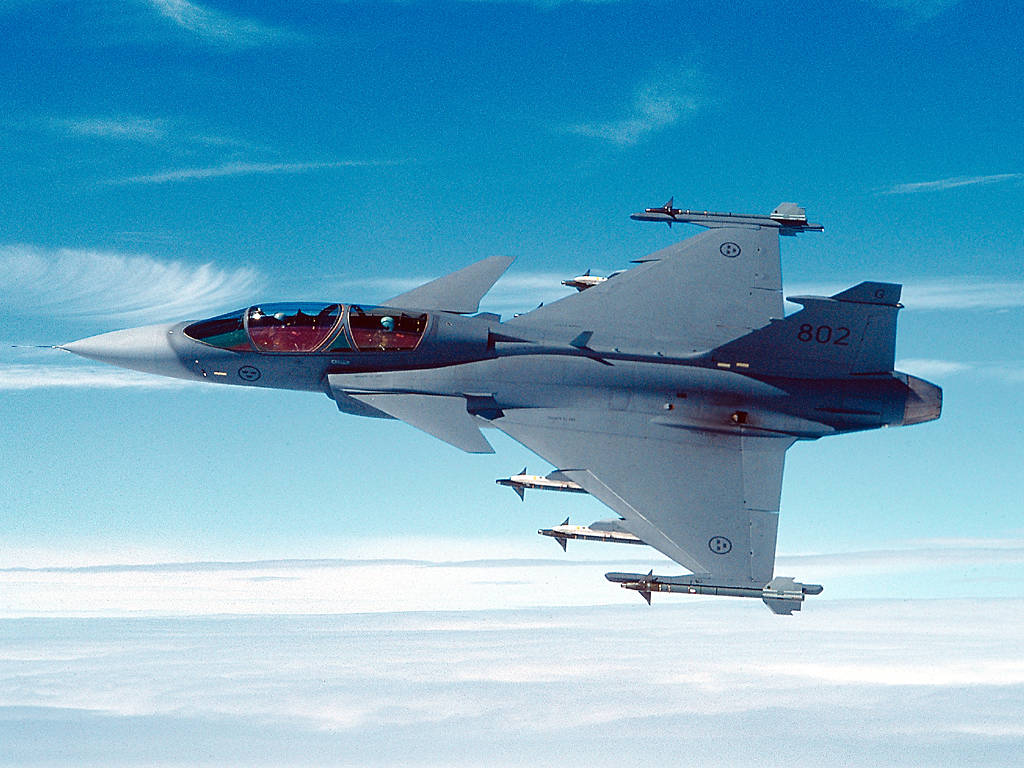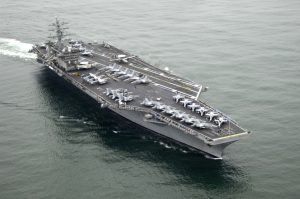Built to replace the Swedish Air Force’s Saab Draken and Viggen fighters, the Gripen project is becoming a popular rival to the European Eurofighter (Typhoon). Saab have won contracts to supply the air forces of the Czech Republic, Hungary, Thailand and South African, beating over Eurofighter to the contracts with its latest incarnation of the Gripen (Swedish for Griffin). While the Typhoon may have superior operational specifications, the Gripen is fast, maneuverable and a highly capable multi task fighter, and is more than a match for its more expensive Eurofighter rival.
Saab produce four varieties of Gripen, the JAS 39A single-seater and JAS 39B two-seater trainer used by the Swedish Air Force, and the JAS 39C and JAS 39D export versions, which feature the same highly maneuverable design and powerful Volvo engines. The Gripen is a single-engine multirole fighter with delta wings and canards, and despite it having been introduced over 14 years ago, the latest incarnation features all the latest fly-by-wire technologies as sported by the more modern Eurofighter.
Specifications
While single-engined, the Gripen’s power plant, a Volvo RM12 turbofan, enables Mach 2 at all altitudes and makes it a lighter fighter compared to the twin-engined Eurofighter. The single-seater Gripen is just over 46 ft in length, the two-seater 48 ft, but both planes have a 27 ft wing span (including launchers) and has a maximum take-off weight of 15 tons, enabling over 11,600 lbs of payload.
With over 650 combat missions to its name, and almost 2,000 flight hours, the Gripen is a more tried and tested alternative to the Typhoon. The Volvo engine is an upgraded version of the General Electric F-404-400, which alone, has notched up several million flight hours of operations
The delta wing-canard design with relaxed stability provides the Gripen with high maneuverability and enables efficient takeoff and landings. The fuselage design is extremely low in drag, maximizing the Gripen’s range and payload capabilities. Although it doesn’t have reverse thrusters to aid engine braking like the Typhoon, the canards can act as air brakes. All versions of the Gripen come equipped with a single 27 mm Mauser, the same as the Eurofighter, although the Typhoon can carry a few thousand pound more in payload.
Features
Despite its 14-year operational age, the Gripen features al the latest fighter technologies, including a Triplex, flight control system, fully integrated avionic system and an efficient human-machine interface system to relieve the workload on the pilot in combat scenarios and maximize the aircraft’s weapon systems. The cockpit and display system has three large, full color displays and holographic combiner heads up display (HUD), and also features a compact, long-range, high-performance pulse Doppler radar, which can handle air-to-air and surface to air defense, as well as reconnaissance duties.
Operational Effectiveness
As with the Eurofighter, the Gripen is designed for modern multitask warfare with emphasis placed on high performance, flexibility and survivability. The initials JAS stand for Jakt (Fighter), Attack (Attack) and Spanning (Reconnaissance) defining its multipurpose role. However, the reason the Gripen is becoming favored over the more sophisticated and maneuverable Eurofighter is the low operational costs, up to 50% lower in most cases. The Gripen can operate with minimum maintenance personnel and ground support from the simplest of road bases. The Gripen also has in-flight refueling capabilities.
Besides the Swedish Air Force’s 204 operational Gripens, the Czech Republic and Hungarian Air Forces each have 14, Thailand a fleet of 12 and South Africa has ordered 26 aircraft. Even the United Kingdom, one of the main investors and customers of the Typhoon Eurofighter project has taken delivery of a number of Gripens as part of its fast jet training program at the Empire Test Pilots’ School, demonstrating the exceptional reputation the Gripen has acquired.



